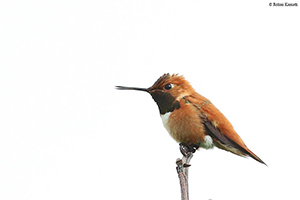 |
Rufous Hummingbird
Selasphorus rufus |
|
|
STANFORD LOCATIONS: Uncommon spring migrant, rarely seen in fall. Most often observed foraging at feeders or flowering trees, especially eucalyptus. |
 |
Location |
Type |
Mating System |
Parental Care |
2ndary Diet |
Strategy |
|
|
|
|
I: 12-14? DAYS ALTRICIAL |
|
|
|
VINE 1 foot - 15 feet (To 50 feet) |
|
(1-3) PROMISC |
F |
|
|
| BREEDING: | Coniferous forest, thickets and brushy slopes, foraging in adjacent meadows. 1, occ 2 broods. |
| DISPLAYS: | Male flies before female in U-shaped, or occ complete oval, pattern. Male ascends with back to female and dives with gorget facing her (as in other hummingbirds). Whining note made at bottom of dive, caused by air rushing through wing feathers. |
| NEST: | Usu on drooping limb; of plant down, covered with lichen, moss, bud scales, leaves, shredded bark, plant fibers, bound with spider's silk, lined with plant down. Often reused and built upon in succeeding years. |
| EGGS: | White, unmarked. 0.5" (13 mm). |
| DIET: | Includes spiders; tree sap. |
| CONSERVATION: | Winters s to s c Mexico. |
| NOTES: | Nests often clustered, appearing semicolonial. Pugnacious defender of nest area. Males arrive well in advance of females on breeding grounds. Fall migration through mountains at high elevation, defending temporary feeding territories; preferentially exploit flowers (along territory periphery) in early morning which are most subject to being usurped by intruding birds. |
| ESSAYS: | Hummingbird Foraging Bouts; Optimally Foraging Hummers; Nonvocal Sounds; Hummingbirds, Nectar and Water; Coevolution; Hovering Flight. |
| REFERENCES: | Gass, 1979; Johnsgard, 1983; Kodric-Brown and Brown, 1978; Paton and Carpenter, 1984; Tyrell and Tyrell, 1984. |
| Help | Abbreviations | Species-Alphabetical | Species-Taxonomic | Essays-Alphabetical | |
| Except for Stanford Locations, the material in this species treatment is taken, with permission, from The Birder's Handbook (Paul Ehrlich, David Dobkin, & Darryl Wheye, Simon & Schuster, NY. 1988). | |||||